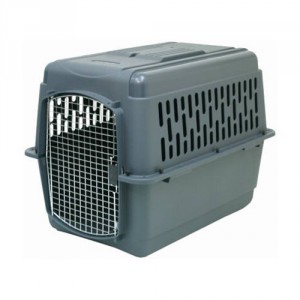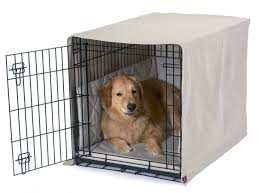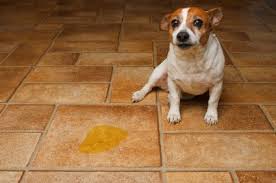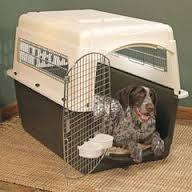Crate training your new dog has many advantages, but is especially important in a multi dog house hold. Not crate training your dogs is one of the biggest mistakes dog owners make and one of the main reasons that dogs end up in shelters, with issues like housebreaking, inappropriate chewing and separation anxiety. When Introducing a new dog in a multi-dog household, a crate or kennel not only provides the new member a quite, safe place of his own, but also allows the training to start off with positive reinforcement.
Adding a crate to your house does not mean forever or always, but… a crate should always be used for a puppy or a dog with an unknown history. A crate is the most important tool you will use, next to a leash, to teach your new pack member impulse control, manners, patience and housebreaking. In return, a crate provides your new dog a place to call his own, a place where the other dogs are not allowed. Your new dogs crate provides a sanctuary for him and lets him feel safe and secure. For this reason I prefer shipping crates, but a wire crate with a blanket covering 3/4 of it works nicely also. Along with a bed, your new dog should initially be fed in his crate, he should have water at all times and he should have things to chew on like antlers or nylabones, And Yes, some dogs will complain, especially puppies, if they have recently been separated from their mother and siblings, puppies will cry and should be given age appropriate things that will help comfort and distract them.

Choosing an appropriate crate should not be difficult, however, there are a lot of crates to choose from so knowing a bit about what kind/size of dog you are looking at will help you make wise choices. I highly recommend a “shipping crate” and here is why:
- Safety! I have seen dogs get their teeth around the wire of a wire crate , un-weld, bend and destroy the crate. Although this dog was not crate trained and his human put him in a crate in a new environment and left. This dog, who I call Budda, is a very high energy lab who now loves the downtime his shipping crate offers him, is happy to go into his Aspenpet Pet Porter Kennel, and is safe and secure when left .
- Ease of use! From the Human perspective, the door says it all! A Crate with a squeeze door latch not only offers you the option upon installation to determine which way the door opens, but can be opened and closed easily with one hand.
- Comfort..! My dogs seem to love to use the sides of their kennels as support when laying up side down. A kennel that uses wingnuts to attach the top to the bottom is the best choice for safety and security.
He Won’t go in his Crate! Okay so you understand the importance of using a crate for your new dog, but HE doesn’t!.. Cookies! lots of Cookies! You may initially have to physically put the dog into the crate for the first few days. However it is important to first throw in a high value treat of some sort.. maybe a piece of cheese, or a piece of chicken. Say the word that you want to associate with going in the crate, I use the work “Kennel”, toss in the special treat and be ready to assist. NEVER be angry or upset with with the dog when teaching him to go in his crate, It should be a happy, peaceful place for him. Once he is comfortable with this, his own personal space, the crate can be used as a “time-out” when your dog is over stimulated, stressed or upset.
A Crate is no place to live… So now you have another crate in your house. This is a great opportunity for the other animals in your house hold to be able to meet your new member through the safety of the door, but this crate does not have to be a permanent thing. Most dogs, once housebroken and comfortable with their surroundings, their fellow pack members, and the security that living in a home with a loving family gives them, adapt well and learn that the entire house is theirs to feel safe and secure in. It is however, important to remember that dogs in a multiple dog household can cause quite a ruckus when left unattended for any period of time, and any small animals could be threatened by “pack mentality”, therefore, It is always a better option to kennel the dog(s) that are high energy, young, nervous or just worried, for the safety of all. Three of my 7 house dogs go into their crates when I am not at home and when I go to bed, all for different reasons, but mostly it helps them feel able to shut down and rest. All three run to their crates when I say the word, and they get a cookie.. Life is Good..!
A Quick Word on Housebreaking.. Housebreaking your new dog is not a difficult process using a crate… IF you are observant, consistent, patient and positive! Depending on your circumstances and your new dogs age, the basic goal is to get your dog to go “Potty” outside. Like any reward based training,the reward comes after a successful trip outside in the form of verbal acknowledgement (Good Dog!), cookies, and freedom in the house. If your new dog is a rescue and you still have reservations about the safety of your other pets then the “freedom in the house” should be on a leash. Again depending on the age of the dog, and time of the day, Freedom may last only 30 minutes. All dogs kept in a crate for any time should be taken outside immediately after being let out of the crate, If the dog does not “potty” when taken outside, it is recommended that the dog be put back in the crate for 30 minutes or so and then try again. Shortly, the dog will connect Potty = reward and freedom.. Puppies generally take a little longer as they learn to regulate their growing bodies, and housebreaking is usually the first human/dog learning that they do.. It is imperative that this first learning be positive and rewarding thus setting up future training success.
Never leave your un-housebroken dog unattended.
 Potty training an older dog … is usually an easy process. If your new dog is a rescue that has not been living in a house he may not understand where the proper place to potty is. Dogs are very in-tuned with our body language and tone of voice, even a new dog will understand a firmly stated”OH NO! WHAT HAPPENED?” , however it is important to remember that rescues often have history and can be very sensitive to a negative tone. Handle a rescue gently and watch his response when correcting bad behavior, lead him to his crate, toss in the cookie and leave him for a bit until it is time to take him outside again for another try.. Never hit, yell scream or grab a new dog for the small infraction of a puddle, hopefully, you will see him potty out side shortly and can lavish him with praise. Often one mistake is all it takes with an adult dog to understand what is expected.
Potty training an older dog … is usually an easy process. If your new dog is a rescue that has not been living in a house he may not understand where the proper place to potty is. Dogs are very in-tuned with our body language and tone of voice, even a new dog will understand a firmly stated”OH NO! WHAT HAPPENED?” , however it is important to remember that rescues often have history and can be very sensitive to a negative tone. Handle a rescue gently and watch his response when correcting bad behavior, lead him to his crate, toss in the cookie and leave him for a bit until it is time to take him outside again for another try.. Never hit, yell scream or grab a new dog for the small infraction of a puddle, hopefully, you will see him potty out side shortly and can lavish him with praise. Often one mistake is all it takes with an adult dog to understand what is expected.
